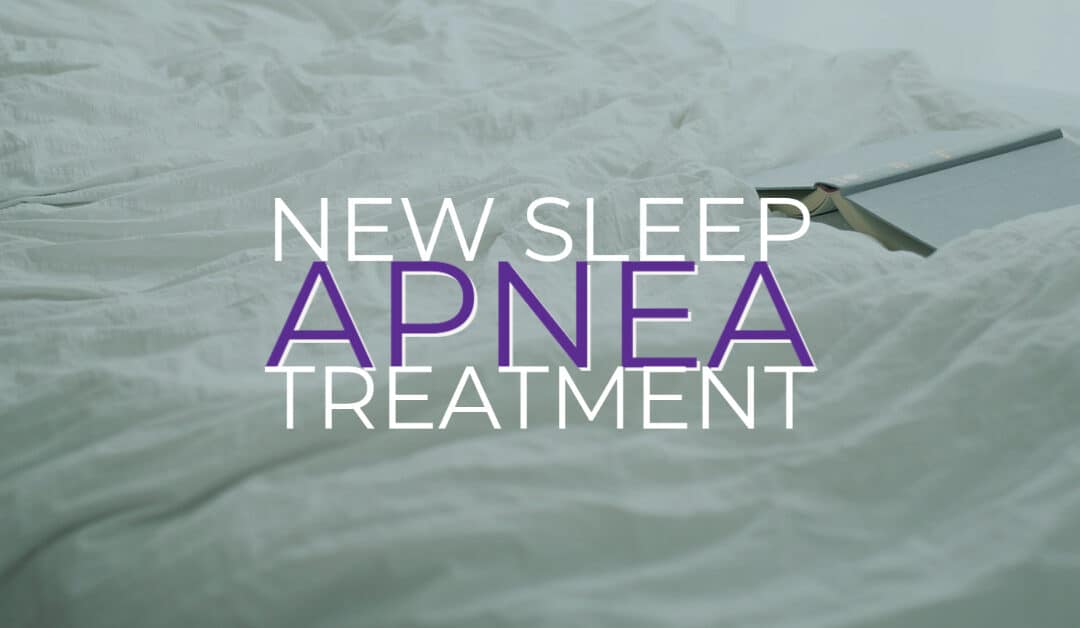If you live with sleep apnea every night, you may have tried a CPAP machine, a mouth device, surgery, essential oils, a new bed, and more. Without your nightly sleep, you may feel desperate for answers. Living day after day without good sleep can feel like a nightmare you can’t wake up from. Without your ZZZ’s, you never quite feel like yourself. However, there is a new sleep apnea treatment that works. Let’s look at this new hope for sleep apnea sufferers and how it works to get you sleeping all night again.
Inspire Therapy
If your ENT doctor diagnoses you with any of the three types of sleep apnea, Inspire Therapy (hypoglossal nerve stimulator) may help you get the ZZZ’s you need. This startling development in medical technology has only recently been FDA-approved for sale by the company that developed the device.
Inspire Therapy is the only FDA-approved obstructive sleep apnea treatment that works inside your body to treat the root cause of sleep apnea with just the click of a button.
Diagnosing Sleep Apnea
Doctors such as ear, nose, and throat (ENT) doctors who specialize in sleep therapies focus their attention on how sleep apnea occurs by studying the latest research developments. Inspire may treat all three sleep apneas, including:
- Central Sleep Apnea: A neuromuscular disturbance where your brain does not properly communicate with your breathing muscles while you sleep
- Obstructive Sleep Apnea: when the breathing problem truly is related to the structure of the bones and muscles in your head and neck.
- Complex Sleep Apnea: Occurs when your facial muscles and bones contribute to your sleep apnea in addition to your brain not communicating with your body about breathing.
Gold Standard Sleep Apnea Treatment?
Doctors in the past have usually recommended a CPAP or BIPAP device to regulate breathing and improve sleep quality for sleep apnea sufferers. While this works for many patients, these devices are cumbersome, difficult to travel with, and can bring side effects such as:
- Air Pressure Issues: feeling like you have to push too hard to breathe out
- Swallowing Air: feeling bloated or having gas
- Headaches and Dizziness
- Uncomfortable Mask: Some people can’t fall asleep easily wearing the mask and hose. It feels awkward and restricts movement as you try to snuggle in and go to sleep. Others feel smothered with something on their nose.
- Mask Leaks: with air leaks, there’s not enough air pressure to prevent sleep apneas
- Mouth and Nose Issues: nose or mouth feeling dry, frequent nosebleeds, stuffy nose
- Sinus and Lung Infections: more frequent infections
- Skin Inflammation: irritated skin around your nose and mouth.
How Inspire Therapy Works for Sleep Apnea
Implanted during a short outpatient procedure, Inspire monitors your breathing while you sleep and delivers mild stimulation to key airway muscles. This stimulation gently moves the tongue and other soft tissues out of the airway to enable breathing during sleep.
Early studies of the Inspire system showed sleep apnea episodes decreased by 68% within the first year. Many recipients also reported:
- Decreased sleepiness
- Decreased effects of obstructive sleep apnea
- improved quality of life
Even four years later, patients reported the ongoing effectiveness of Inspire therapy “with regard to subjective measures of quality of life.” (1)
The Science Behind Inspire
Contemporary research focuses on the functional causes of obstructive sleep apnea including:
- Impaired airway dilator activity including the impaired upper-airway anatomy of OSA. In other words, the throat is too full of muscles or other tissues due to the design of your bones and the size of your tissues OR the muscle activity does not work correctly. In other words, you may possess anatomical AND neuromuscular factors that cause your obstructive sleep apnea
- Failure of the neuromuscular feedback loop: This is the known cause of central sleep apnea
According to Respirology, “Considerable evidence illustrates the overlap between CSA and obstructive sleep apnoea (OSA).” Treatment of OSA, by CPAP, tracheostomy, or oral appliances, can reveal that the OSA patient also suffers from central sleep apnea. When this overlap happens, a patient is said to suffer from complex sleep apnea. (1)
Hypoglossal nerve stimulation, the Inspire treatment system, is the new treatment option that takes advantage of the newest research about neurofeedback-loop dysfunction.
So Exactly How Does Inspire Work for Sleep Apnea?
If eligible, your ENT doctor will schedule a time for you to undergo a small procedure implanting the Inspire device. You will work with your doctor to carefully regulate the device to deliver comfortable levels of stimulation.
The Inspire device very simply works with your body to help you breathe by:
- Sensing chest wall movement during sleep and when needed, comfortably stimulating your hypoglossal nerve.
- Your hypoglossal nerve then causes your genioglossus muscle to contract.
- When the genioglossus muscle contracts, it moves and shifts the tongue slightly forward, enlarging your airway.
- You breathe freely and easily without sleep disruption
Whether you suffer from complex, obstructive, or central sleep apnea, Inspire could work to help you enjoy restful nights and energetic mornings again. Meet with your ENT doctor to determine if this new medical solution might work for you.
We Can Help
At Enticare, we help patients all across Arizona get their ZZZ’s again. Our focus as sleep specialists is finding the treatment solution that is best for your system. Whether we prescribe the Inspire device, changing your sleep position, CPAP, BIPAP, surgery, a mouth device, or weight loss measures, you can know that we want the best outcome for you. Work with us to find out how to sleep well again. Schedule a sleep study to determine your health issues and we will walk you through the steps to find your way. Contact us today to set up an appointment so we can begin helping you sleep well and wake up refreshed again.
Footnotes:
- https://pubmed.ncbi.nlm.nih.gov/31584412/
- https://academic.oup.com/sleep/article/39/3/511/2453930
- https://www.ncbi.nlm.nih.gov/pmc/articles/PMC5161664/
- https://www.umc.edu/Healthcare/ENT/Patient-Handouts/Adult/Sleep_Surgery/Inspire.html#:~:text=The%20process%20of%20activation%20is,over%20the%20next%20several%20weeks.
- https://onlinelibrary.wiley.com/doi/10.1111/resp.12927

